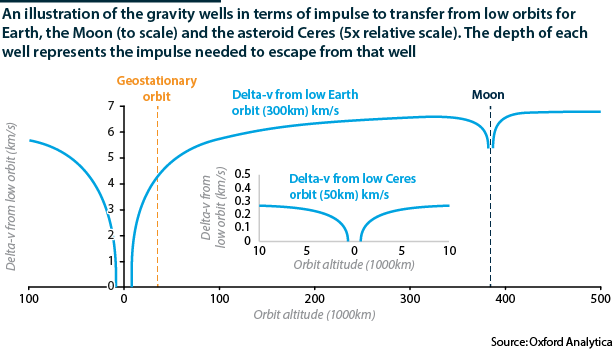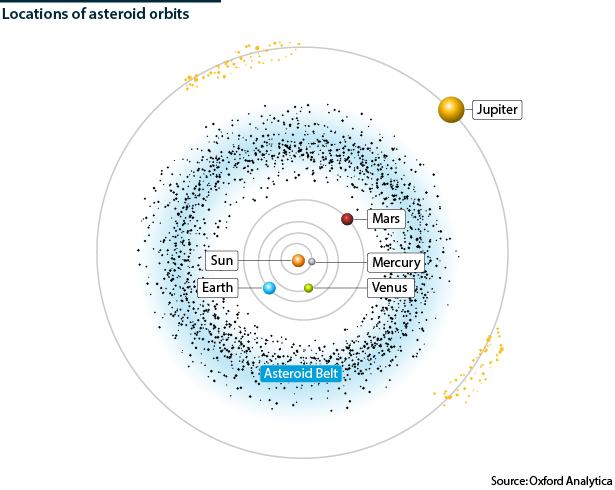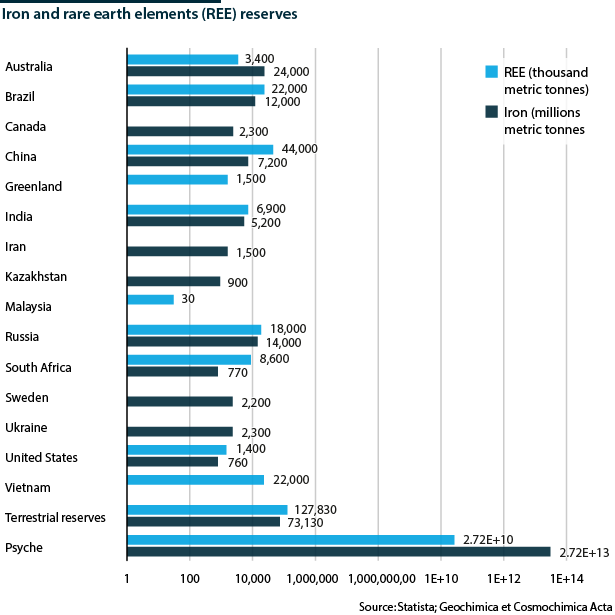Asteroid mining becomes a serious proposition
Governments and firms are seriously examining the potential for a space economy based on resources from asteroids
The US firm Planetary Resources in April completed successful tests in orbit of technology it plans to use to prospect for natural resources on asteroids from 2020. Separately, the China Academy of Launch Vehicle Technology late last year announced long-term plans for large-scale asteroid mining. Meanwhile, US legislators have begun laying the legal foundations for a space mining industry. Significant technological challenges remain, but key technologies have already been demonstrated, making the industry a serious prospect.
What next
An internationally accepted framework for property rights over space resources will be required for large-scale investment to take place. Moves towards this are underway and will gather pace as the industry's technological viability is demonstrated. The sector will depend on parallel development of space-based manufacturing technology, since the commercial value of asteroid mining will lie in making raw materials available for space-based refuelling and manufacturing, rather than bringing precious metals back to Earth.
Subsidiary Impacts
- An investment bubble could follow dramatic early successes or technological breakthroughs.
- There may be international tension over ownership or priority of access unless new international legal frameworks are agreed in advance.
- Asteroid mining will not be a viable solution to terrestrial resource depletion for the foreseeable future.
Analysis
Launching into orbit from the Earth's surface is extremely expensive. For example, the Ariane 5 rocket has an initial mass (mostly fuel) of about 800 tonnes but is only capable of putting 20 tonnes into low-Earth orbit, at a cost of more than 180 million dollars.
This high cost is a bottleneck on the expansion of the space economy (see PROSPECTS 2017-22: Space - December 2, 2016). Reducing it is a major focus for private launch companies and space agencies alike, for example SpaceX and its development of reusable rockets (see INTERNATIONAL: SpaceX will greatly expand space access - February 14, 2018).
The problem of high launch costs would be avoided altogether if satellites and other spacecraft could be constructed and fuelled in space from materials sourced there.
Travelling in space requires much less energy than getting into space from Earth. For example, to reach a 300-kilometre-altitude orbit, a spacecraft must achieve a speed of about 10 kilometres per second. Once there, however, it only needs an additional 5 kilometres per second to propel it out of Earth's gravitational well completely and send it to an asteroid hundreds of millions of kilometres away.
Launching from Earth requires powerful high-thrust rockets, but in low gravity, weaker thrusts over long durations can do the same job. Travel between asteroids and Earth's orbit could in principle be achieved using less powerful but much cheaper propulsion systems.
All this makes it potentially cheaper to mine a tonne of material in space and bring it back to Earth orbit than it is to launch it into orbit from the Earth's surface.
The asteroid mining industry is premised on turning these potential cost savings into reality.
The asteroids
The asteroid belt is a region of small bodies in independent orbits around the Sun, lying mainly between the orbits of Mars and Jupiter. About 500,000 asteroids with diameters ranging from 1,000 kilometres down to a few kilometres have been catalogued, tracked and their orbits defined. Discovery has accelerated in recent years. The number of sub-kilometre asteroids probably runs into the millions.
Many asteroids follow orbits that intersect Earth's, sometimes making close approaches. Some of these 'near-Earth asteroids' are ideal targets for prospecting and exploitation. Currently about 18,000 are tracked and around 2,000 are potentially accessible. Many are rich in metals, materials and propellant necessary for developing space-based industries.
Resources potentially available
Asteroids come in various types, with broad categories of carbon-rich, stony and 'M-type' (potentially metallic). These may consist of pure or alloyed metals rather than oxides or ores as commonly found on Earth. This would make them an ideal source of raw material for manufacturing, since the processing and refining required for terrestrial metals would not be necessary.
There is also significant evidence that asteroids are rich in resources needed to provide propulsion and potentially habitation in space, water in particular. The US company Deep Space Industries (DSI) has developed water-based propulsion systems for use initially on small satellites. This technology is scalable, and would mean that spacecraft could refuel from water-rich asteroids instead of having to carry all their fuel from Earth, cutting the cost of deep space spaceflight significantly.
Asteroids contain all the raw materials needed to support a space-based economy
Extraction and processing
Exploration technologies have already been developed and demonstrated. Japan's Hayabusa mission (2005-10) returned a sample from the asteroid Itokawa that provided direct evidence of its mineralogy. NASA's ongoing Dawn mission to the two largest asteroids (Ceres and Vesta) has confirmed the presence of water and hydrated minerals.
However, major technological gaps exist with regard to extraction and processing.
Low gravity and vacuum offer advantages for processing materials. There is no contamination from airborne chemicals or particles, and much larger and more complex structures can be built than are possible in the high-gravity conditions on Earth.
Low gravity creates challenges, too. Extraction equipment must be 'anchored' to a surface. Relevant technologies have been tested, with varying success, but this field will require significant and imaginative solutions.
Processing faces similar issues. Metal objects cannot be 'forged' or 'cast' in low gravity, but 3D printing is being explored with growing success. The US firm Made In Space has tested 3D printing aboard the International Space Station, and has demonstrated the capability to generate large structures.
Current initiatives
Private initiatives and state agencies, often in partnership, are developing and testing technologies for prospecting and fabrication.
The US firm DSI is developing:
- small, low-cost deep space exploration and prospecting systems;
- propulsion technologies such as water-based systems; and
- 'aerobraking' for returning materials to Earth or Mars.
Planetary Resources, another US firm, plans multiple prospecting missions from 2020.
NASA provides grants, support and facilities to firms to test and develop asteroid mining technologies.
China last year announced an ambitious space programme which includes capturing and returning an asteroid to lunar orbit in the 2020s and envisages large-scale asteroid mining by mid-century. Whether this happens on schedule or not, the rapid progress and energy of China's space programme suggest it will be a major player (see CHINA: Space programme will rebound from setbacks - August 29, 2017).
The government of Luxembourg, which set up and part-owns the world's first and largest commercial satellite operator (SES), hopes to repeat this first-mover advantage. It is establishing a legal structure for space mining and has announced 200 million euros (232 million dollars) in subsidies. DSI and Planetary Resources have offices and partnerships there. Luxembourg's government in January signed a memorandum of understanding with China's space administration.
Separate markets
Asteroid mining generates impressive but misleading headlines.
The asteroid Psyche, for example, has been stated as being worth 10,000 quadrillion dollars at current market values. This is misleading. Psyche contains some 3 million times the known global iron reserves, but returning this much material to Earth would catastrophically depress the market price.
Returning asteroidal material to Earth on this scale is in any case not feasible for the foreseeable future. DSI's NASA-supported aerobraking initiative aims to fabricate heatshields from asteroidal material to protect payloads during the descent through Earth's atmosphere. It is unclear what the maximum payload would be, but it is unlikely to represent a significant amount of, say, iron, compared with terrestrial reserves.
Few current initiatives focus on returning material 'in bulk' to Earth.
Space-mined iron is unlikely to affect terrestrial prices
Parallel economy
The rationale for space-based mining and fabrication is that the radical cost savings, relative to launching from Earth, would enable space-based activities that are technologically possible today but unviable due to the massive cost of launches.
The result would be a space economy that operates in parallel with the terrestrial economy, with a high-cost connection between the two. This has been likened to the ancient Silk Road along which small quantities of high-value goods circulated between the independent economies of Europe and China.
Some materials of value could be returnable from space: materials that are rare on Earth and not needed in large quantities, such as the rare earth elements and platinum group elements used in high-performance engineering, electronics and the chemical industry.
This would probably not be enough to sustain a space-mining industry by itself, and may become at least partly redundant following Japan's recent discovery of vast accessible seabed deposits of rare earths.
Law and politics
The international framework for use of outer space largely dates from the Cold War and rests on the 1967 Outer Space Treaty.
The treaty's main provision relevant to space mining is that no state may lay exclusive claim to a 'celestial body'. It makes no explicit mention of resource recovery and use.
The generally accepted situation today is that private or public ownership of extracted resources and resulting products or services is permitted, but not property rights over the body on which mining takes place.
With growing interest and investment in the space resources sector, some governments have begun constructing legal frameworks to clarify rules on ownership, liabilities and responsibilities in order to encourage investor confidence.
The US Commercial Space Launch Competitiveness Act of 2015 allows exploitation of space resources by US citizens and organisations where compatible with international law and agreements, albeit in very general terms and ambiguous language.
The other country to legislate is Luxembourg, which hopes to carve out an international niche in the sector with a July 2017 law recognising ownership of resources extracted in space by any individual or firm registered in the country.
Before large-scale activities take place beyond research and prospecting, new international treaties and institutions will be required in order to clarify issues such as:
- at what point ownership is conferred in the process of prospecting and extraction;
- whether the capture of small (say 100-metre) asteroids counts as 'taking possession' or 'resource extraction';
- dispute resolution;
- how compliance can be monitored hundreds of millions of kilometres from Earth; and
- what sanctions are available if international agreements are violated.
Legal structures could be strained if organisations and governments try to force operations into existing frameworks.
Barriers
Development of the space mining sector faces at least two threats:
Technological barriers
The technological difficulties may be greater than anticipated. It may simply prove impossible or prohibitively costly to extract resources of sufficient purity or quality.
Substitutes
A fundamental breakthrough in launch technology would reduce the cost of space mining, but might also reduce launch-to-orbit costs enought to make it more cost-effective to source materials from Earth.
Novel types of launch technology that might do this are being explored. The UK company Reaction Engines Limited is developing a jet-rocket hybrid spaceplane engine. China Aerospace Science and Technology Corporation is also developing a hybrid spaceplane. Both hope for test-flights in the mid-2020s. China also plans to test an aircraft-launched spaceplane by 2030.
Other more speculative candidates include a centrifuge-based 'catapult' proposed by US start-up SpinLaunch.
Indirect opportunities
The need for new techniques in precision engineering, extraction, processing and fabrication will create opportunities for firms that have expertise in these areas but are not currently active in the space industry.
The need for new treaties, legislation and regulation will create opportunities for lawyers and associated professions.
Outlook
Over the coming decade, firms and governments will identify suitable targets for prospecting, while extraction, propulsion and processing technologies are developed.
Full exploitation is decades away at the earliest, but could ultimately lead to a massive reduction in cost for the rest of the space industry and a dramatic expansion of the space economy and scientific space exploration.



_350.jpg)